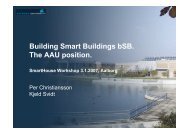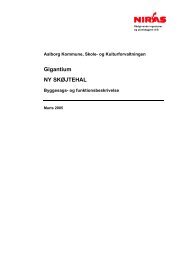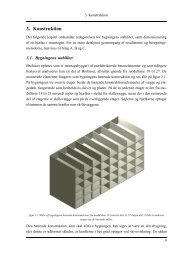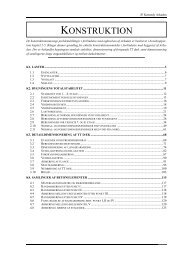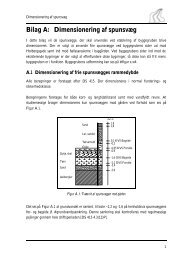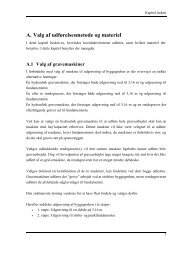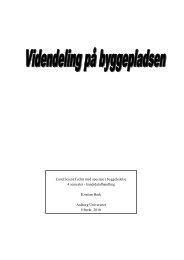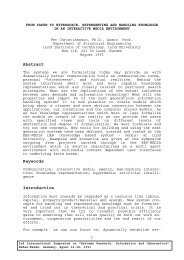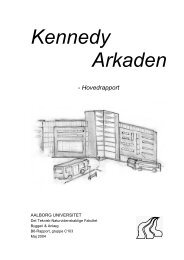ICT-supported end user participation in creative and ... - It.civil.aau.dk
ICT-supported end user participation in creative and ... - It.civil.aau.dk
ICT-supported end user participation in creative and ... - It.civil.aau.dk
Create successful ePaper yourself
Turn your PDF publications into a flip-book with our unique Google optimized e-Paper software.
were different requirements on placement of thereception dep<strong>end</strong><strong>in</strong>g on if it was watched from theentrance or from the <strong>in</strong>side of the entrance hall.The function of the reception related to today<strong>and</strong> future expected functionality was further discussed<strong>in</strong> the Functional Build<strong>in</strong>g Systems Consolidation(FCON) space. Revised solutions wereevaluated <strong>and</strong> discussed <strong>in</strong> the SOL space. See alsoFigures 3–4.A special VR-Wii solution was developed atRambøll provid<strong>in</strong>g the <strong>user</strong>s a simple <strong>and</strong> cost efficientway to navigate <strong>in</strong> the virtual build<strong>in</strong>gs solutions<strong>in</strong> the SOL space. See Figure 5.A particular <strong>user</strong> group was early established totake care of <strong>end</strong> <strong>user</strong> needs <strong>in</strong> connection with <strong>in</strong>teriors<strong>and</strong> facilities <strong>in</strong> meet<strong>in</strong>g spaces <strong>and</strong> commonlocations. In this case VIC-MET was used late <strong>in</strong>the process <strong>in</strong>volv<strong>in</strong>g a choice of specific furniture<strong>and</strong> their placements. Solutions were presented <strong>in</strong>both virtual <strong>and</strong> real sett<strong>in</strong>gs <strong>in</strong> the exist<strong>in</strong>g office.The ma<strong>in</strong> activities took place <strong>in</strong> the FCON <strong>and</strong>SOL spaces. Special regards to possibilities forhous<strong>in</strong>g both social <strong>and</strong> more private meet<strong>in</strong>gswere studied <strong>in</strong> the café space. See Figure 6.4.2 The Arkitema headquarter caseThe Arkitema office project started <strong>in</strong> 2005. Thekick-off procedure <strong>and</strong> early workshops from thiswork gave fruitful <strong>in</strong>put to the VIC-MET development.An <strong>in</strong>tentional focus <strong>in</strong> the office design wasFigure 4. Entrance alternative 2 <strong>in</strong> the new RambollHead Office.Figure 5. A special VR-Wii solution was developed atRamboll.Figure 6. The comb<strong>in</strong>ed café <strong>and</strong> meet<strong>in</strong>g space at thenew Ramboll Head Office.Figure 3. Entrance alternative 1 <strong>in</strong> the new RambollHead Office.to keep the design activities on a high abstractionlevel with focus on common values, needs <strong>and</strong>functional build<strong>in</strong>g performance. User <strong>in</strong>volvementprocedures for the VIC-MET were set-up<strong>and</strong> evaluated for the office space design case.108
Figure 7. Video documentation of design, evaluationactivities <strong>in</strong> the SOL space at the Panorama VRMediaLabAalborg University.Figure 8. Use of symbols <strong>in</strong> the virtual build<strong>in</strong>g officespace to evaluate placements of privileged meet<strong>in</strong>gplaces <strong>in</strong> the Panorama respectively Cave at the AalborgUniversity.Alternative solutions were partly changed<strong>and</strong> evaluated <strong>in</strong> the Panorama <strong>and</strong> Cave at theVRMediaLab at Aalborg University. <strong>It</strong> was concludedthat it was feasible to make real timechanges, annotations, <strong>and</strong> to store different solutions.<strong>It</strong> was also concluded that is very importantto work on a uniform abstraction level, dep<strong>end</strong>enton design context <strong>and</strong> <strong>user</strong> skills. See Figures 7–8.4.3 Late Bra<strong>in</strong> Injury Center caseF<strong>in</strong>ally VIC-MET was assessed <strong>in</strong> connection withdesign of a Late Bra<strong>in</strong> Injury Center <strong>in</strong>clud<strong>in</strong>gpatient hous<strong>in</strong>g, tra<strong>in</strong><strong>in</strong>g facilities <strong>and</strong> Liv<strong>in</strong>g Labfacilities for Aalborg University. See Figure 9. Inthis case the architect for a first alternative presentationcompiled the <strong>end</strong> <strong>user</strong>s needs <strong>and</strong> wishes.The architect leads the walk-through for a broad(15 persons) <strong>end</strong>-<strong>user</strong> representation of clients,patient relatives, AE design team, nurses, <strong>and</strong> universityLiv<strong>in</strong>g Lab researchers. Feed-back fromFigure 9. User Involvement <strong>in</strong> the design of The LateBra<strong>in</strong> Injury Center Frederikshavn Denmark. VIC-METdevelopment support.evaluations <strong>in</strong> the SOL space were used as <strong>in</strong>putto the architect for further iteration <strong>and</strong> alternativeevaluations.5 ConclusionsThe VIC-MET was developed to support <strong>user</strong><strong>participation</strong> <strong>in</strong> <strong>in</strong>novative <strong>and</strong> <strong>creative</strong> build<strong>in</strong>gdesign. The method supports <strong>user</strong> <strong>in</strong>volvement <strong>in</strong>every phase of the construction process <strong>and</strong> with aunique setup dep<strong>end</strong><strong>in</strong>g on design context.VIC-MET has validated the need for enhancedmethods to <strong>in</strong>volve <strong>end</strong>-<strong>user</strong>s <strong>in</strong> a collaborative/participative <strong>creative</strong> <strong>and</strong> <strong>in</strong>novative build<strong>in</strong>gdesign process. The <strong>in</strong>dustry partners also appreciatethe development, enhancement <strong>and</strong> extensionof exist<strong>in</strong>g methods for <strong>user</strong> <strong>in</strong>volvement <strong>in</strong> thebuild<strong>in</strong>g process.The VIC-MET will support a future moreperformance based design process <strong>and</strong> developmentof ontologies to better describe functional build<strong>in</strong>gsystems. See also (Christianson et al. 2009b).109
ReferencesBeyer, H. & Holtzblatt, K. 1998. Contextual Design.Def<strong>in</strong><strong>in</strong>g Customer-Centered Systems. San Francisco:Morgan Kauf- mann Publishers.Br<strong>and</strong>t, E., Johansson, M. & Messerter, J. (2005). “TheDesign Lab: Re-th<strong>in</strong>k<strong>in</strong>g What to design <strong>and</strong> How toDesign”. (pp. 34–43). Design Spaces (2005). Edited byThomas B<strong>in</strong>der, Maria Hekkström. IT Press. EditaPublish<strong>in</strong>g Ltd, F<strong>in</strong>l<strong>and</strong>. 203 p.Christiansson, P., Sørensen, K.B., Rødtness, M.,Abrahamsen, M., Ostenfeld, L.R. & Alsdorf, M.2008. User driven <strong>in</strong>novation <strong>in</strong> the build<strong>in</strong>g process.Journal of Ts<strong>in</strong>ghua University-Science <strong>and</strong> Technology.Elsevier. Volume 13. Number S1. October 2008.ISSN 1007-0214 40/67. CN 11-3745/N, CODENTSTEF7. Elsevier. (pp. 248–254).Christiansson, P., Sørensen, K.B., Steffensen, K.G. &Svidt, K. 2009a. User driven <strong>in</strong>novative build<strong>in</strong>gdesign. Proceed<strong>in</strong>gs of the CIB W78, 26th InternationalConference on ‘Manag<strong>in</strong>g IT <strong>in</strong> Construction’.CRC Press, Balkema. October 1–3 2009, IstanbulTechnical University. ISBN 978-0-415-56744-2 (hbk),ISBN: 978-203-85978-o (eBook) (pp. 333–340).Christiansson, P., Svidt, K. & Sørensen, B. 2009b. Future<strong>in</strong>tegrated design environments, Journal of InformationTechnology <strong>in</strong> Construction (ITcon), Vol. 14,Special Issue Next Generation Construction IT: TechnologyForesight, Future Studies, Roadmapp<strong>in</strong>g, <strong>and</strong>Scenario Plann<strong>in</strong>g, pp. 445–460, http://www.itcon.org/2009/29Gero, J.S. & Maher, M.L. Modell<strong>in</strong>g Creativity <strong>and</strong>Knowledge-Based Creative Design. Hillsdale,New Jersey: Lawrence Erlbaum, 1993.Novak, J.D. & Cañas, A.J. 2006. “The Theory Underly<strong>in</strong>gConcept Maps <strong>and</strong> How to Construct <strong>and</strong> UseThem”, Technical Report IHMC CmapTools, FloridaInstitute for Human <strong>and</strong> Mach<strong>in</strong>e Cognition.Pittaway, L., Robertson, M., Munir, K., Denyer, D. &Neely, A. (2004). Network<strong>in</strong>g <strong>and</strong> <strong>in</strong>novation: a systematicreview of the evidence. International Journalof Management Reviews, 5/6, 137–168.Rogers, E.M. (2003). Diffusion of Innovations, New York,Free Press.Von Hippel, Eric. Democratizong Innovation. USA: MITPress, 2005.110



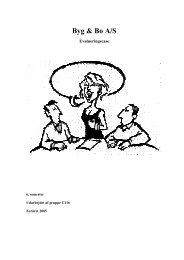
![[abs ID] PAPER TITLE - IT in Civil Engineering. Aalborg University](https://img.yumpu.com/51222254/1/184x260/abs-id-paper-title-it-in-civil-engineering-aalborg-university.jpg?quality=85)
